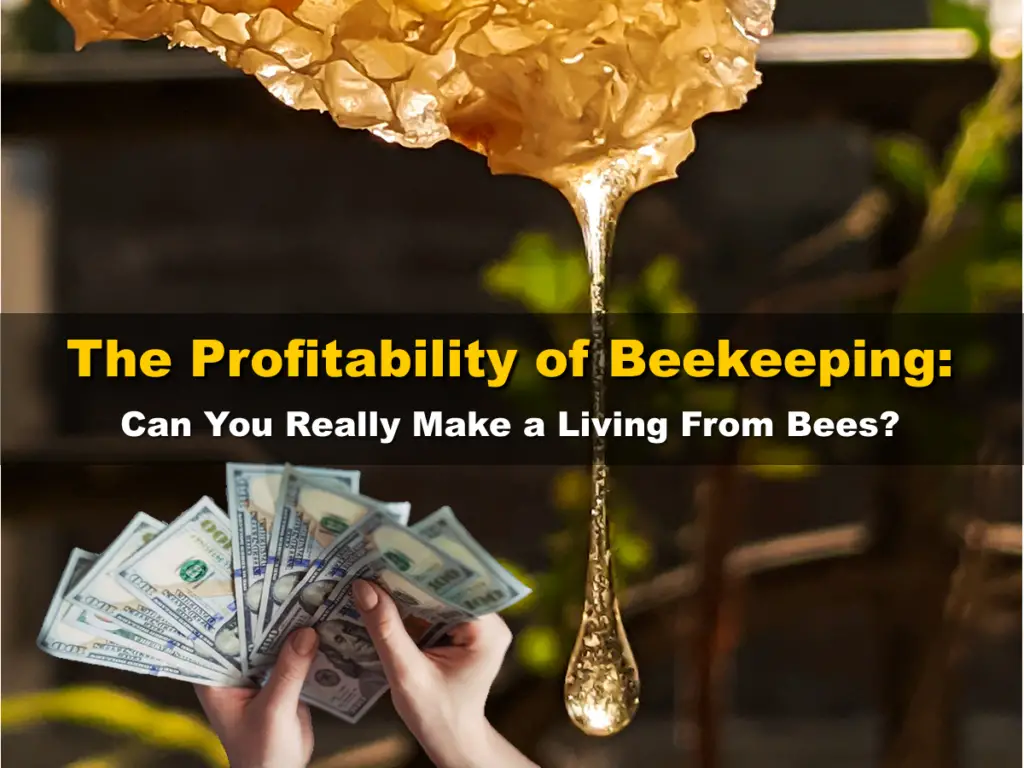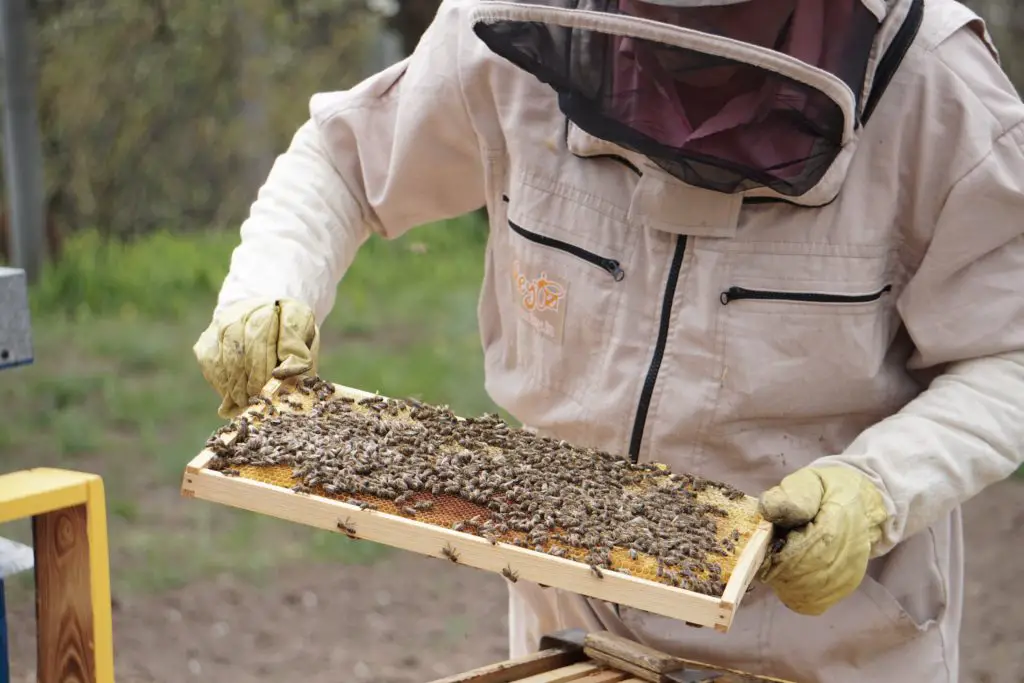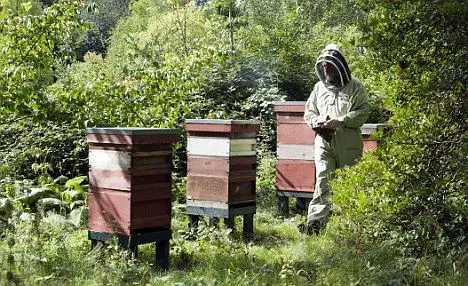Affiliate Disclaimer - As an Amazon Associate I earn from qualifying purchases.
It supports the website. So, Thank you
Side hustles have become the norm for a lot of people and more and more folks are taking the plunge and starting a small business. But regardless of whether you’re looking to make a full-time income or something on the side, there are tons of ways you can do this.
For anyone with a passion for nature, beekeeping might seem like the ideal business venture and a lot of people assume it’ll be a lucrative one. But in reality, how profitable is beekeeping?
While it is possible to turn beekeeping into a viable business, you have to go big if you want to make serious money. Having a single hive isn’t going to make you a lot of, if any, profit.
New beekeepers also have to keep in mind that there are some start-up costs involved and within the first year, as the hive matures, it’s unlikely that the bees will produce enough honey to feed themselves and provide some leftovers for you.
However, with hard work, determination, and several hives, it is possible to make a profitable business out of beekeeping. In this guide, I’ll be explaining everything you need to know to get started and what to expect in terms of making money.
Table of Contents
How Can You Make Money From Beekeeping?
When people think about selling bee products, their minds usually drift to honey but this isn’t the only way you can make a profit from your bees. Before we get into the nitty-gritty of actually starting your own apiculture business, let’s look at how you’re going to get that cash flowing.
Honey
Honey is in high demand and it’s something that is never going to go out of fashion. What’s more, people are super keen to buy raw honey that is locally produced and the great thing about it is that you won’t have to break the bank to produce it.
A lot of beekeepers will use specific flowers for their bees to gather nectar as this can alter the taste of the honey. The more unique you can make it, the more interesting it will be to potential customers. But do keep in mind that it’s always best to use native plants for your bees.
Another advantage of selling honey is that natural honey usually sells for a lot more than the mass-produced stuff you find in the grocery store. In some cases, it could be up to $10 per pound but I’ll go into the profit you might make later in this guide.
One thing that new beekeepers should be aware of is that honey production won’t be lucrative in the first year. A new colony of bees will normally only produce enough to feed themselves in the first year so you’ll need to wait for the hive to become more established before you can profit from it. Moreover, the amount of honey you’ll get each year could change depending on things like bee health, what nectar is available, and even the weather.
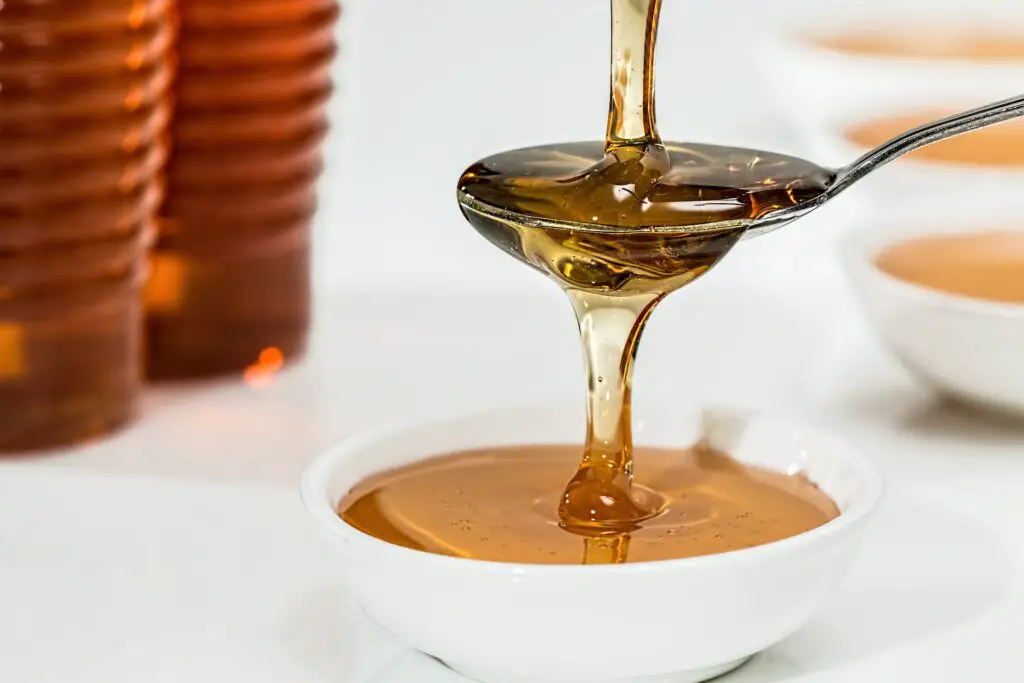
Propolis
Propolis is a sticky resinous substance that bees use to disinfect the hive and repair any damage to it. But humans make use of this in the health market and propolis is purported to have a lot of medicinal purposes. New beekeepers may not be aware of the value of propolis but if you’re going to start a profitable business, it’s something worth clueing yourself up on.
You will need to buy a propolis trap if you’re going to harvest this substance and keep in mind that you’re not going to get copious amounts. Still, even a small colony can create consistent amounts that’ll bring in a little more profit than if you weren’t selling it.
Pollen And Pollination
As we all know, bees take pollen from flowering plants and then take it to their hive. They use this as a source of protein and it’s incredibly important to them. However, pollen is also used as a supplement for humans and it sells at a very good price on the health market, largely because your hive isn’t going to produce serious amounts of excess pollen.
On top of this, you have to be aware that there are very specific times for harvesting pollen and you’ll only be able to collect it a couple of days out of each week.
Just like collecting propolis, you’ll need a pollen trap for harvesting and this will be placed at the opening to the hive.
As well as selling pollen, a lot of beekeepers will rent their colonies out for pollination. In some cases, this is the only thing that a beekeeper will do as this can be a very profitable venture. Of course, if you want to go down this route then you will need to have a significant number of hives to make money.
I’d also recommend considering this further down the line in your beekeeping career as this is something that requires a good level of experience.
Wax
Bees produce wax and this is something else that can be harvested and sold to make a profit. It’s possible to sell beeswax as it is but a lot of people make products from it such as candles or personal care items like lip balm.
The thing that you have to keep in mind about beeswax is the profit will vary between locations. Plus, you’ll usually get a lot more for selling items made with beeswax than you would be selling it raw but then your workload will also be higher so it kind of balances things out.
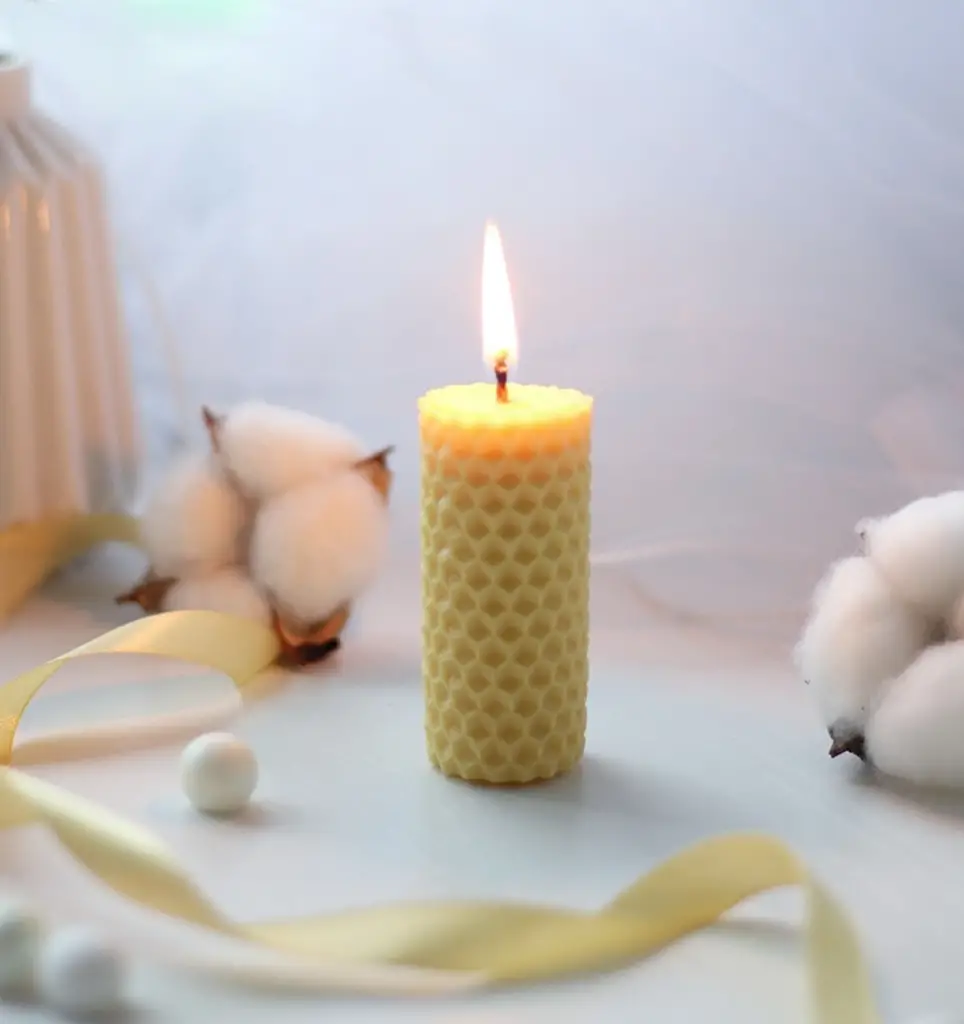
Royal Jelly
Sometimes called bee milk, royal jelly is a white substance that’s high in protein and comes from the worker bees’ glands. In the hive, this substance is used as food for the bee larvae during the first few days after they’re born. The only time that a bee would feed on royal jelly for longer than this would be if she was chosen to be the queen. This bee would then be given the substance throughout its development and into adulthood.
This is one of the most profitable things you can sell from your beehive as there isn’t a lot of it. When harvesting do make sure that you leave enough for the bees and also keep in mind that harvesting it isn’t the easiest thing in the world so this is something else that should be reserved for when you’ve gained more experience.
Beekeeping Start Up Costs
While it’s very possible to turn beekeeping into a viable business, nothing comes for free and there are some start-up costs associated with beekeeping. How much this will set you back depends on the size of the business you’re looking to create. However, if you’re completely new to beekeeping, I wouldn’t recommend going crazy from the off.
In fact, complete beginners would be better off buying a single hive and doing apiculture as a hobby for at least a year. This will give you an idea of whether you enjoy it enough to turn it into a business and allow you room to make mistakes. So many new beekeepers give up after the first year as there can be a lot of trials and tribulations. If you spend a small fortune on starting a business only to find that it doesn’t go well, that can be devastating.
In any case, let’s take a look at some of the costs you will need to consider.
Beehives And Equipment
You can’t start a beekeeping business without hives and there are options when it comes to what you purchase. A lot of people would agree that a 10-frame unassembled hive is the best option purely because they aren’t assembled so cost less to buy. Of course, you will need to do a bit of DIY once you get the hive but if you enjoy that sort of thing then it’ll be a cinch!
I’d also recommend looking for a hive that’s been treated with wax as this will be more affordable and will save you the hassle of having to paint it yourself.
You can purchase beehive kits that typically include two or three boxes, a foundation and frames. If you’re a beginner, this is usually the better option and there’s always the choice to buy additional boxes once the colony begins to establish itself. Generally speaking, you might pay up to $200 for one of these kits.
In addition to the hive, you’re going to need to invest in things like a hive tool, bee smoker, and protective gear. While the cost of these items isn’t very much, it still needs to be factored in.
Bees
Your hive would be utterly useless without the hum of life so one of the start-up costs you’ll need to consider is that of your bees. This is one of the most expensive parts of getting set up and the more hives you have, the more bees you’re going to need to buy.
A typical nuc comes in at about $150 but it’s also possible to buy a hive with bees already in it for a little less at around $100. These options will always come with a queen but should anything happen to her, you’ll need to buy a new one and this will normally be about $25.
Your first hive, including bees, will normally cost around $500 to set up. But any subsequent hives won’t be as much and I’d recommend budgeting between $200-$250 for each additional one.
Honey Extraction
You probably won’t need a honey extractor if you’re starting off with just a few hives. However, if you’re going all out and have several hives then this will be a useful thing to have as it’ll really speed up how quickly you can harvest honey.
There are electric and manual honey extractors. A manual device will normally be about $150 whereas an electric one could cost up to $300. On top of this, you will need to invest in an uncapping knife although these aren’t a lot and usually won’t be more than about $30.
Brand And Marketing Costs
If you’re setting up a business, you need to let the world know about it otherwise you aren’t going to sell any products. This means investing money in marketing and branding.
You’ll want to think about things like creating a logo that you can have on your honey jars and other products. The cost of this includes the production of the logo itself as well as having labels and other items printed with it on.
Your jars and containers will also cost money and if you really want to make a statement, you could produce branded merchandise like t-shirts and hoodies. This might sound a little out there for a new business but even if you just make a few to start with and wear them, this will bring brand awareness to the local area.
Any good business has an online presence so you’ll incur website fees and online advertising fees. Plus, if you’re going to use software for tracking your business revenue, this is going to come at a cost as well.
How Many Beehives Can One Person Manage?
I’ve made it clear earlier in this guide that it’s not really a very wise idea to buy hundreds of hives from the get-go. Not only is there a serious chance of failure but taking all this on in one go can be a lot of hard work, especially if you’re doing beekeeping alongside your full-time job.
At your peak, you’ll likely be able to manage up to 150 hives on your own and it’s perfectly feasible to do this while still being in full-time employment. Once you leave your job and put all of your focus into your apiculture business, you could have up to 800 hives and manage perfectly well. However, at the height of the season, you’ll probably want to hire some help to make harvesting easier.
You’ll also need to consider how you’re going to make your money. Some beekeepers only raise the bees and then sell them for a profit and this is significantly less work than if you’re beekeeping for honey. On top of this, you’ll need to invest extra money into your business for harvesting equipment.
While it is possible for a single beekeeper to raise and sell bees within up to 150 hives, this can be difficult to do off the bat. It’s recommended to start off with as little as two hives and gradually work your way up to more. People who do beekeeping as a hobby and are experienced may only keep up to 25 colonies at once but this is at the serious end of the scale.
Once you have this many hives, you’ll need to be a lot more meticulous with your planning. Of course, how easy it is to maintain the hives will depend on things like whether you need to travel to the hives and how good your equipment is.
If you find that you’re easily able to manage 25 hives, you might then consider investing in more and at this stage, a lot of people take the leap of caring for up to 100 hives. By now, you’ll be investing serious amounts of cash into your business so you’ll need to make sure that you’re making a profit.
You’ll likely also find that beekeeping will take up a lot of your free time and by now, it could be worth considering where you’ll go from here. If you double the number of beehives and have around 200, it’s time to throw in the towel on your day job and put your primary focus on beekeeping. This can feel daunting but it’s make or break now!
But when you think about the number of hives that any individual can manage, a lot of it depends on how much previous experience they have, the time they’re willing to invest, and how well they plan their business. If you’re really dedicated, you could manage several hundred hives as a full-time job although you’d still want seasonal staff for harvesting.
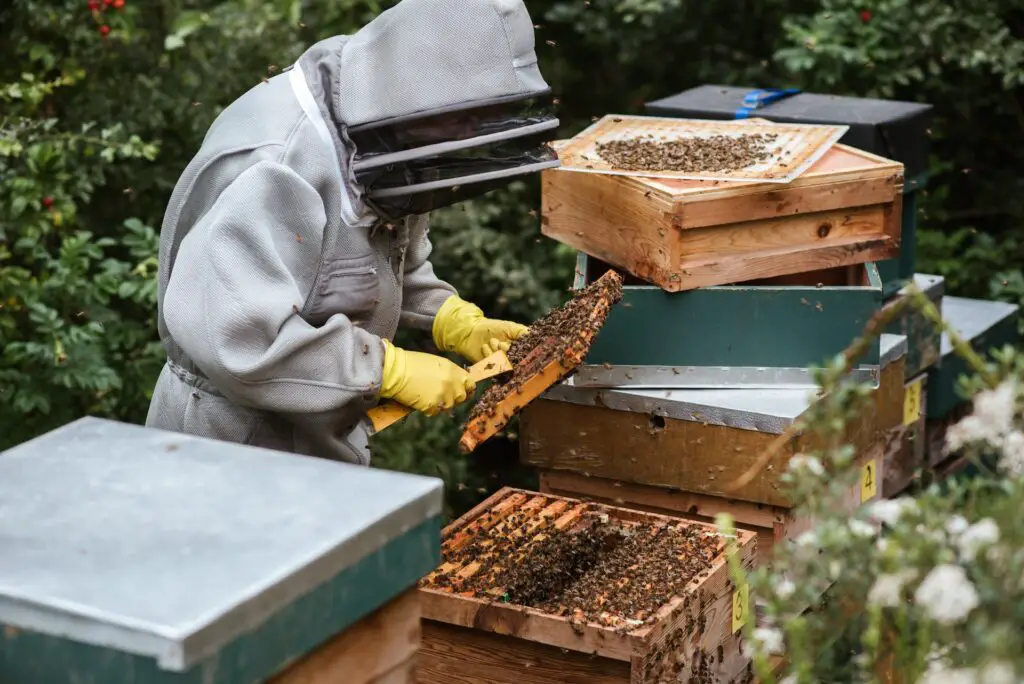
How Much Profit Can I Expect To Make From Beekeeping?
After reading all of the above information, you may feel as though beekeeping is something that you could have a go at. But one of the most common questions for newcomers is how much profit they’ll actually make.
In the USA, a typical beekeeper could earn between $28,000 and $44,000 a year which equates to between $14 and $22 an hour. This is in line with other agricultural careers.
That said, it is possible to earn significantly more than this with experience and some pro beekeepers are earning more than $65,000 every year. But you probably wouldn’t expect to get to this level until you’d been practising apiculture for at least five years.
It’s also worth keeping in mind that no two beekeepers are the same and how much you earn can be affected by things such as your location. It is possible to gain experience by taking on a seasonal or part-time job with an established apiarist before fully committing to your own business.
Now, in terms of what you’ll earn, it’s worth thinking about the cost of each individual product or service. For example, a healthy hive could produce as much as 100 lbs of honey each season. You will need to leave plenty behind for the bees but from this, you could gather 60 lbs.
It’s really up to you how much you sell your honey for but keep in mind that it’s OK to charge more for natural honey than for the stuff you get in the supermarkets so be realistic with your pricing. Location will play a role in the price you can charge but generally speaking, you wouldn’t expect to charge less than $10 per pound. If your harvest is 60 lbs then you stand to earn up to $600 per hive per season.
But what about wax? Well, you could sell this for as little as $12 a pound or as much as $20 a pound. Of course, if you’re willing to put in the extra mile and make beeswax products then you will earn more. For example, a good beeswax candle will sell for at least $20, potentially more.
There’s also pollen to think about. While the hive won’t produce as much of this, there’s still money to be made. You’ll normally get up to $5 an ounce and if you’re selling propolis in chunks then this could fetch up to $8 per ounce. If you sell propolis extract then you could get almost double this for every ounce you sell.
As I mentioned earlier, the business of renting out bees for pollination can be a business venture in itself and many beekeepers only do this. In most circumstances, you will be able to get between $40 and $150 for pollination but this will depend on the season.
Some beekeepers take it one step further and make money from educating people about beekeeping. You could give tours of your hives, sell online courses or offer mentoring. The options are endless and how much you charge for these services will depend on your level of experience.
Conclusion
Beekeeping is a great way to make money if you are willing to be patient. For newbies, it’s not a good idea to buy hundreds of hives and hope to make a fortune because that probably isn’t going to happen.
This is something that requires experience and each hive will need at least one year to establish in order to produce enough honey to make a profit. So, normally, I’d advise you to buy just one or two hives to start and do beekeeping as a hobby before you expand it into a business.
But once you have gotten the relevant experience and begun selling bee products, it is possible to make upwards of $65,000 a year and quit your full-time job. It’s a dream of many people to work for themselves and be flexible and if you love nature and are willing to work hard, this might be the right business for you.

